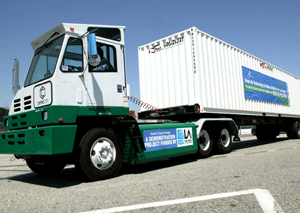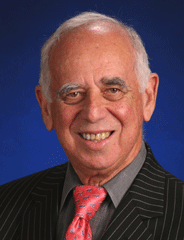Cargo, Clean and Quiet
Air Date: Week of May 16, 2008

(Photo: B. Samra)
Imagine a heavy-duty truck, fully electric, that can haul 60 thousand pounds for 30 miles on one charge. The seaport of Los Angeles is about to receive 25 electric port vehicles, and officials expect them to catch on at ports worldwide. Living on Earth’s Ingrid Lobet reports from Los Angeles.
Transcript
GELLERMAN: It’s Living on Earth. I’m Bruce Gellerman. The Los Angeles seaport is the largest in the country. Cargo ships from Asia arrive laden with all variety of stuff from electronic devices to toys to clothes, all packed in steel containers. Giant cranes then load the containers onto tractor trailer trucks, which haul them away. These heavy trucks are a major source of soot, or ‘particles,’ in the LA region. But soon the port will clean up its act when twenty-five all-electric trucks arrive.
The electric trucks won’t just help reduce air pollution. As Living on Earth's Ingrid Lobet reports, officials predict they could spark a change in seaports around the world.
[TRUCK ENGINE RUNNING]
LOBET: Forty-thousand times a day, heavy diesel rigs scurry in, out and around the port of Los Angeles, picking up, dropping off and just waiting around, idling. Dirty air and noise are two of neighbors’ and workers’ main complaints about the port, so when David Freeman became chief of the Harbor Commission two years ago, he took on these issues with zeal.
FREEMAN: When I got here on this commission, I was handed this report that said we’re gonna cut pollution in half, back to what it was in 2001. And I looked at the report, and it said that we’re now causing thirty-five hundred premature deaths. And I said well, half of that is seventeen hundred fifty people. We can’t kill seventeen hundred fifty people. We have to have a standard of reaching healthy air.

Dr. Geraldine Knatz is Executive Director of the Port of Los Angeles. (Courtesy of the Port)
FREEMAN: We’ve been told by the experts that whether it’s LNG or biodiesel – whatever you burn – if you burn something you’re gonna have a tiny, small particulate matter. And these folks are right there at lung-level breathing that stuff. So to have a vehicle that will not burn anything that will just be run on electricity is a fundamental cleanup. This is not show; this is really tell.
[GEARS CLICK IN PLACE; MAN SAYS ‘LET’S START IT UP HERE’; ELECTRIC TRUCK ENGINE WHIRS ON]
FLUEGAL: A lot quieter than your standard diesel truck, huh? Yeah, it's real nice.
[ELECTRIC TRUCK RUNNING]
LOBET: Michael Fluegal is a vocational laborer at the port and drives a lot of heavy equipment.
FLUEGAL: We're real proud of it. When I got involved with the truck myself, you know, I had my doubts. But we’ve threw everything but the kitchen sink at it and it just keeps performing, so it’s just short of spectacular. It’s – we've hauled as much as sixty-eight thousand pounds on this truck, and it just keeps on ticking.
[TRUCK DECELERATES; POWERS DOWN AND SWITCHES OFF]
LOBET: Experts agree running a vehicle on electricity, even when half of it comes from coal, as here, is much cleaner than burning diesel. But David Freeman says the port plans to run the truck on solar, and already has the first megawatt out to bid.
The person who shepherded this project from ‘let's do it’ to ‘here it is!’ is Balwinder Samra. He's an electric vehicle expert who helped golf carts go electric, and sold electric delivery trucks in Mexico. He remembers when electric forklifts were new.
SAMRA: I still remember customers use to not believe us when we would go in and say this one is electric. And I was very surprised, once the economic analysis got around, that industry switched very fast.
LOBET: Samra was struck by how short the hauling distances were at the port, usually less than twenty-five miles to regional warehouses and railroad connections, and often less than half a mile from one spot in the port to another.
SAMRA: It was a ideal opportunity for electric vehicles.
LOBET: And with the cost of diesel skyrocketing, the timing seemed right, too. The electric trucks can cost seventy thousand dollars more than diesel trucks up front, but battery recharging saves money compared to fuel.
SAMRA: Just an example, if we tried to do this in 1980s, we had dollar-a-gallon type stuff so I would be right now telling you we can save you five thousand dollars a year. Not as compelling is it? Today, because of the pricing, we have a thirty-five thousand dollar argument, which at least perks up somebody's ears and they say let's talk about this more.

David Freeman heads the Los Angeles Harbor Commission. (Courtesy of the Port of Los Angeles)
LOBET: The team chose traditional lead-acid batteries for price and reliability. They hope a next-generation battery will increase charging speed and capacity. To keep the trucks operating, workers have to recharge them four hours at night, and also briefly during shift changes. They use a smart charger that can charge four vehicles at a time, and adjust the flow of juice to each one depending on need.
Samra's company, Balqon, is still working out the kinks in those distribution algorithms. He says when the frustrations of new-product development weigh him down, he remembers the reception the first truck got from port employees.
SAMRA: There were like twenty people whipping out their cell phones and trying to take the images of that thing. It was very exciting.
LOBET: Officials think half the eight thousand trucks needed at the port could be electric. That could potentially eliminate two hundred tons annually of one principal pollutant: NOx. Even before the Port of LA's electric trucks are announced, Samra says he's been deluged with calls.
SAMRA: A lot of interest from West coast ports, Canada, Italy, Pacific Asia. There’s a lot of people calling us. It just seems like a lot of people were waiting for this to happen.
LOBET: Over the last decade the southern California seaports have been shaken by their reputation as the largest polluters in the nation's most polluted region. Angry communities have sued and shut down nearly all port expansion. Now the new leadership at the ports hopes they'll be able to do something that didn't seem possible a few years ago: expand, and get much cleaner, at the same time.
For Living on Earth, I’m Ingrid Lobet in Los Angeles.
[HUM OF TRUCK ENGINE]
Links
Living on Earth wants to hear from you!
Living on Earth
62 Calef Highway, Suite 212
Lee, NH 03861
Telephone: 617-287-4121
E-mail: comments@loe.org
Newsletter [Click here]
Donate to Living on Earth!
Living on Earth is an independent media program and relies entirely on contributions from listeners and institutions supporting public service. Please donate now to preserve an independent environmental voice.
NewsletterLiving on Earth offers a weekly delivery of the show's rundown to your mailbox. Sign up for our newsletter today!
 Sailors For The Sea: Be the change you want to sea.
Sailors For The Sea: Be the change you want to sea.
 The Grantham Foundation for the Protection of the Environment: Committed to protecting and improving the health of the global environment.
The Grantham Foundation for the Protection of the Environment: Committed to protecting and improving the health of the global environment.
 Contribute to Living on Earth and receive, as our gift to you, an archival print of one of Mark Seth Lender's extraordinary wildlife photographs. Follow the link to see Mark's current collection of photographs.
Contribute to Living on Earth and receive, as our gift to you, an archival print of one of Mark Seth Lender's extraordinary wildlife photographs. Follow the link to see Mark's current collection of photographs.
 Buy a signed copy of Mark Seth Lender's book Smeagull the Seagull & support Living on Earth
Buy a signed copy of Mark Seth Lender's book Smeagull the Seagull & support Living on Earth

